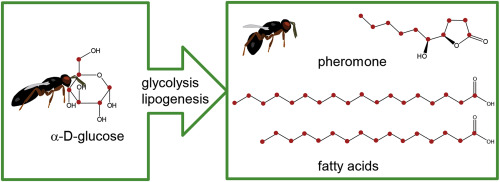当前位置:
X-MOL 学术
›
Insect Biochem. Mol. Biol.
›
论文详情
Our official English website, www.x-mol.net, welcomes your
feedback! (Note: you will need to create a separate account there.)
De novo biosynthesis of fatty acids from α-D-glucose in parasitoid wasps of the Nasonia group.
Insect Biochemistry and Molecular Biology ( IF 3.2 ) Pub Date : 2019-10-23 , DOI: 10.1016/j.ibmb.2019.103256
Lorena Prager 1 , Astrid Bruckmann 2 , Joachim Ruther 1
Insect Biochemistry and Molecular Biology ( IF 3.2 ) Pub Date : 2019-10-23 , DOI: 10.1016/j.ibmb.2019.103256
Lorena Prager 1 , Astrid Bruckmann 2 , Joachim Ruther 1
Affiliation

|
Fatty acids are indispensable primary metabolites for virtually any organism on earth and thus enzymatic machinery enabling de novo production of fatty acids from carbohydrates is highly conserved. A series of studies has questioned the ubiquity of lipogenesis in parasitoid wasps suggesting that the vast majority of species have lost the ability to synthesize fatty acids de novo. One such species is Nasonia vitripennis, which, like the congeneric species N. giraulti and N. longicornis, uses a fatty acid-derived male sex pheromone for sexual communication. Here we demonstrate by feeding fully 13C-labeled α-D-glucose and analyzing insect-derived fatty acid methyl esters and the male sex pheromone by coupled gas chromatography/mass spectrometry that both males and females of N. vitripennis as well as N. giraulti and N. longicornis are capable of synthesizing fatty acids de novo. We furthermore show by a proteomics approach that predicted fatty acid synthase, ATP-citrate synthase, and acetyl-CoA carboxylase, key enzymes of lipogenesis, are expressed in the male pheromone gland of N. vitripennis and N. giraulti. Labeling experiments with Urolepis rufipes, a closely related species producing a male sex pheromone independently of fatty acids via the mevalonate pathway, revealed that both sexes are likewise able to synthesize fatty acids de novo. We conclude that the parasitoid wasp species studied here, irrespective of the biosynthetic origin of their sex pheromones, are capable of responding flexibly to lipid shortage during their adult life by keeping enzymatic machinery for lipogenesis running.
中文翻译:

从头开始在Nasonia组的类寄生蜂中从α-D-葡萄糖合成脂肪酸。
脂肪酸实际上是地球上任何生物必不可少的主要代谢产物,因此高度保守了能够从碳水化合物从头生产脂肪酸的酶促机制。一系列研究对寄生类黄蜂中脂肪生成的普遍性提出了质疑,表明绝大多数物种已失去了从头合成脂肪酸的能力。一种这样的物种是Nasonia vitripennis,与同类物种N. giraulti和N. longicornis一样,使用脂肪酸衍生的男性性信息素进行性交流。在这里,我们通过完全饲喂13C标记的α-D-葡萄糖并通过气相色谱/质谱联用分析昆虫衍生的脂肪酸甲酯和雄性信息素来证明N. vitripennis和N. giraulti的雄性和雌性和N。Longicornis能够从头合成脂肪酸。我们进一步通过蛋白质组学方法表明预测的脂肪酸合酶,ATP柠檬酸合酶和乙酰辅酶A羧化酶(脂肪生成的关键酶)在N. vitripennis和N. giraulti的雄性信息素腺中表达。乌雷氏金鱼(Urolepis rufipes)是一种密切相关的物种,通过甲羟戊酸途径产生独立于脂肪酸的雄性信息素,其标记实验表明,这两种性别同样能够从头合成脂肪酸。我们得出的结论是,无论研究其性信息素的生物合成来源如何,在此研究的拟寄生蜂均能通过保持酶促脂肪生成的机制,在成年后灵活应对脂质短缺。我们进一步通过蛋白质组学方法表明预测的脂肪酸合酶,ATP柠檬酸合酶和乙酰辅酶A羧化酶(脂肪生成的关键酶)在N. vitripennis和N. giraulti的雄性信息素腺中表达。乌雷氏金鱼(Urolepis rufipes)是一种密切相关的物种,通过甲羟戊酸途径产生独立于脂肪酸的雄性信息素,其标记实验表明,这两种性别同样能够从头合成脂肪酸。我们得出的结论是,无论研究其性信息素的生物合成来源如何,在此研究的拟寄生蜂均能通过保持酶促脂肪生成的机制,在成年后灵活应对脂质短缺。我们进一步通过蛋白质组学方法表明预测的脂肪酸合酶,ATP柠檬酸合酶和乙酰辅酶A羧化酶(脂肪生成的关键酶)在N. vitripennis和N. giraulti的雄性信息素腺中表达。乌雷氏金鱼(Urolepis rufipes)是一种密切相关的物种,通过甲羟戊酸途径产生独立于脂肪酸的雄性信息素,其标记实验表明,这两种性别同样能够从头合成脂肪酸。我们得出的结论是,无论研究其性信息素的生物合成来源如何,在此研究的拟寄生蜂均能通过保持酶促脂肪生成的机制,在成年后灵活应对脂质短缺。在V.tripennis猪笼草和Giraulti猪笼草的雄性信息素腺中表达。乌雷氏金鱼(Urolepis rufipes)是一种密切相关的物种,通过甲羟戊酸途径产生独立于脂肪酸的雄性信息素,其标记实验表明,这两种性别同样能够从头合成脂肪酸。我们得出的结论是,无论研究其性信息素的生物合成来源如何,在此研究的拟寄生蜂均能通过保持酶促脂肪生成的机制,在成年后灵活应对脂质短缺。在V.tripennis猪笼草和Giraulti猪笼草的雄性信息素腺中表达。乌雷氏金鱼(Urolepis rufipes)是一种密切相关的物种,通过甲羟戊酸途径产生独立于脂肪酸的雄性信息素,其标记实验表明,这两种性别同样能够从头合成脂肪酸。我们得出的结论是,无论研究其性信息素的生物合成来源如何,在此研究的拟寄生蜂均能通过保持酶促脂肪生成的机制,在成年后灵活应对脂质短缺。揭示了男女都同样可以从头合成脂肪酸。我们得出的结论是,无论研究其性信息素的生物合成来源如何,在此研究的拟寄生蜂均能通过保持酶促脂肪生成的机制,在成年后灵活应对脂质短缺。揭示了男女都同样可以从头合成脂肪酸。我们得出的结论是,无论研究其性信息素的生物合成来源如何,在此研究的拟寄生蜂均能通过保持酶促脂肪生成的机制,在成年后灵活应对脂质短缺。
更新日期:2019-10-23
中文翻译:

从头开始在Nasonia组的类寄生蜂中从α-D-葡萄糖合成脂肪酸。
脂肪酸实际上是地球上任何生物必不可少的主要代谢产物,因此高度保守了能够从碳水化合物从头生产脂肪酸的酶促机制。一系列研究对寄生类黄蜂中脂肪生成的普遍性提出了质疑,表明绝大多数物种已失去了从头合成脂肪酸的能力。一种这样的物种是Nasonia vitripennis,与同类物种N. giraulti和N. longicornis一样,使用脂肪酸衍生的男性性信息素进行性交流。在这里,我们通过完全饲喂13C标记的α-D-葡萄糖并通过气相色谱/质谱联用分析昆虫衍生的脂肪酸甲酯和雄性信息素来证明N. vitripennis和N. giraulti的雄性和雌性和N。Longicornis能够从头合成脂肪酸。我们进一步通过蛋白质组学方法表明预测的脂肪酸合酶,ATP柠檬酸合酶和乙酰辅酶A羧化酶(脂肪生成的关键酶)在N. vitripennis和N. giraulti的雄性信息素腺中表达。乌雷氏金鱼(Urolepis rufipes)是一种密切相关的物种,通过甲羟戊酸途径产生独立于脂肪酸的雄性信息素,其标记实验表明,这两种性别同样能够从头合成脂肪酸。我们得出的结论是,无论研究其性信息素的生物合成来源如何,在此研究的拟寄生蜂均能通过保持酶促脂肪生成的机制,在成年后灵活应对脂质短缺。我们进一步通过蛋白质组学方法表明预测的脂肪酸合酶,ATP柠檬酸合酶和乙酰辅酶A羧化酶(脂肪生成的关键酶)在N. vitripennis和N. giraulti的雄性信息素腺中表达。乌雷氏金鱼(Urolepis rufipes)是一种密切相关的物种,通过甲羟戊酸途径产生独立于脂肪酸的雄性信息素,其标记实验表明,这两种性别同样能够从头合成脂肪酸。我们得出的结论是,无论研究其性信息素的生物合成来源如何,在此研究的拟寄生蜂均能通过保持酶促脂肪生成的机制,在成年后灵活应对脂质短缺。我们进一步通过蛋白质组学方法表明预测的脂肪酸合酶,ATP柠檬酸合酶和乙酰辅酶A羧化酶(脂肪生成的关键酶)在N. vitripennis和N. giraulti的雄性信息素腺中表达。乌雷氏金鱼(Urolepis rufipes)是一种密切相关的物种,通过甲羟戊酸途径产生独立于脂肪酸的雄性信息素,其标记实验表明,这两种性别同样能够从头合成脂肪酸。我们得出的结论是,无论研究其性信息素的生物合成来源如何,在此研究的拟寄生蜂均能通过保持酶促脂肪生成的机制,在成年后灵活应对脂质短缺。在V.tripennis猪笼草和Giraulti猪笼草的雄性信息素腺中表达。乌雷氏金鱼(Urolepis rufipes)是一种密切相关的物种,通过甲羟戊酸途径产生独立于脂肪酸的雄性信息素,其标记实验表明,这两种性别同样能够从头合成脂肪酸。我们得出的结论是,无论研究其性信息素的生物合成来源如何,在此研究的拟寄生蜂均能通过保持酶促脂肪生成的机制,在成年后灵活应对脂质短缺。在V.tripennis猪笼草和Giraulti猪笼草的雄性信息素腺中表达。乌雷氏金鱼(Urolepis rufipes)是一种密切相关的物种,通过甲羟戊酸途径产生独立于脂肪酸的雄性信息素,其标记实验表明,这两种性别同样能够从头合成脂肪酸。我们得出的结论是,无论研究其性信息素的生物合成来源如何,在此研究的拟寄生蜂均能通过保持酶促脂肪生成的机制,在成年后灵活应对脂质短缺。揭示了男女都同样可以从头合成脂肪酸。我们得出的结论是,无论研究其性信息素的生物合成来源如何,在此研究的拟寄生蜂均能通过保持酶促脂肪生成的机制,在成年后灵活应对脂质短缺。揭示了男女都同样可以从头合成脂肪酸。我们得出的结论是,无论研究其性信息素的生物合成来源如何,在此研究的拟寄生蜂均能通过保持酶促脂肪生成的机制,在成年后灵活应对脂质短缺。

































 京公网安备 11010802027423号
京公网安备 11010802027423号